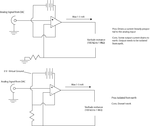Bill.Connelly
Newbie level 4
Hi,
I need to build a device that converts the 0-10V output of the DAC port on my DAQ to a constant current source, in the range of 0-1mA. However, the output needs to be isolated from ground. Finally, the output needs to reach it's steady state level within about 20 microseconds. I am rubbish at electronic design (biologist). So I can not figure this out. I can see how to make an non isolated one, but not a non-isolated one.

I purchased a commercial version at significant expensive, but it's temporal response was compeltely inadequate. But otherwise nice.

Please, can someone help me. I really would appreciate hand holding on this, specific part numbers etc. The less time I spend figure out this (and blowing up poorly selected op-amps), the more time I can spend trying to cure epilepsy, and figure out how the brain transits from wakefulness to sleep. However, any help appreciated.
Edited image one to make what is required clearer
I need to build a device that converts the 0-10V output of the DAC port on my DAQ to a constant current source, in the range of 0-1mA. However, the output needs to be isolated from ground. Finally, the output needs to reach it's steady state level within about 20 microseconds. I am rubbish at electronic design (biologist). So I can not figure this out. I can see how to make an non isolated one, but not a non-isolated one.

I purchased a commercial version at significant expensive, but it's temporal response was compeltely inadequate. But otherwise nice.

Please, can someone help me. I really would appreciate hand holding on this, specific part numbers etc. The less time I spend figure out this (and blowing up poorly selected op-amps), the more time I can spend trying to cure epilepsy, and figure out how the brain transits from wakefulness to sleep. However, any help appreciated.
Edited image one to make what is required clearer
Attachments
Last edited:

